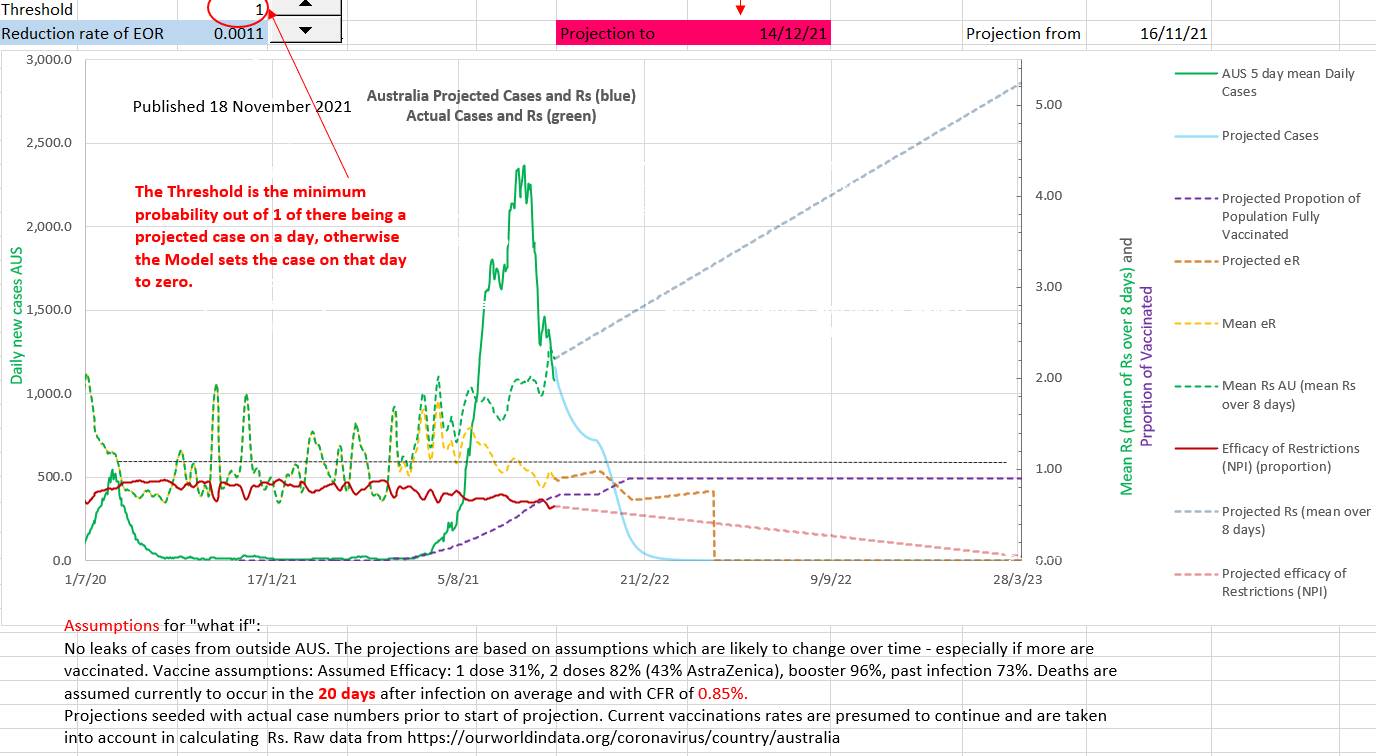Estimating the 'Safe' rate of reduction of Restrictions
The 'Safe' rate of reductions of Restrictions (or the rate of reduction of the Efficacy of Restrictions, EOR) can be estimated using the model by inputting varying rates of reduction of the restrictions. The Efficacy of Restrictions (EOR) is a number between 0 and 1 indicating that restrictions are 0% effective to 100% effective. On 16 November 2021 the EOR in Australia was 0.59.
trictions are the non-pharmaceutical interventions (NPI) put in place to reduce the reproduction number amongst the susceptible from R₀ to Rs (the effective reproduction number amongst the susceptible). Thus Rs can have a value between 0 and R₀. The infection is only replicating amongst the susceptible and thus the restrictions are only effective amongst the susceptible.
The default effective R (eR, effR or Re) of the common SIRS model of infection does not take the changing susceptibility status of the population into account. It is suggested that Rs, the reproduction number amongst the susceptible, is a better, more intuitive measure of the driving force of the infection (epidemic). R₀ is the value of Rs when the population is fully susceptible before restrictions (NPI) are put in place.
Rs = R₀ * (1- EOR)
The default effective R (eR) does have a useful property. It is above 1 if cases are increasing (exponentially) and below 1 if cases are decreasing. It gives an early warning (often missed) of the start of a new wave.
The default effective R (eR, effR or Re) of the common SIRS model of infection does not take the changing susceptibility status of the population into account. It is suggested that Rs, the reproduction number amongst the susceptible, is a better, more intuitive measure of the driving force of the infection (epidemic). R₀ is the value of Rs when the population is fully susceptible before restrictions (NPI) are put in place.
Rs = R₀ * (1- EOR)
The default effective R (eR) does have a useful property. It is above 1 if cases are increasing (exponentially) and below 1 if cases are decreasing. It gives an early warning (often missed) of the start of a new wave.
The Threshold is the minimum probability (between 0 and 1) of there being a case on a day, otherwise the Model sets the case on that day to zero.
The drop in case numbers is projected to slow from 16 November onwards and eR tends towards 1. But, hopefully, the vaccination of children aged 5 to 11 reduces eR because the vaccinations shrink the number of susceptible in the population. What eR hides is that the infection reproduction Rs amongst the susceptible continues to rise above 2.
The drop in case numbers is projected to slow from 16 November onwards and eR tends towards 1. But, hopefully, the vaccination of children aged 5 to 11 reduces eR because the vaccinations shrink the number of susceptible in the population. What eR hides is that the infection reproduction Rs amongst the susceptible continues to rise above 2.
Increasing the rate of reduction of restrictions to 0.0016 precipitates a projected new wave.
Reducing the threshold is also projected to start a new wave. Here there must be a 0.5 (50%) probability of a case projected on any day, otherwise the model sets the cases on that day to zero. Reducing the restrictions (the efficacy of restrictions ) by 0.15% a day (0.0015 a day) still produces a projected new wave.
Finally at a threshold of 0.01 (a single case must be more than 1% likely to occur on a day to be counted as a case) and reducing restrictions (the efficacy of restrictions) by no more than an average of 0.12% per day no new wave is projected. The maximum average rate of reduction of restrictions is estimated to be 0.12% (0.0012) a day, ending in March 2023.
Restrictions act only on the susceptible. It is rational to target restrictions towards individuals who have a high probability of being susceptible, subject to medical exemption. Restrictions do not act on the non-susceptible, so targeting restrictions on those who have a high probability of being non-susceptible would be unproductive.
Restrictions act only on the susceptible. It is rational to target restrictions towards individuals who have a high probability of being susceptible, subject to medical exemption. Restrictions do not act on the non-susceptible, so targeting restrictions on those who have a high probability of being non-susceptible would be unproductive.
Download a video about estimating the 'safe' average rate of Reduction of Restrictions here:
To Follow.
| safe_reduction_of_restrictions_and_rs_video.mp4 |






